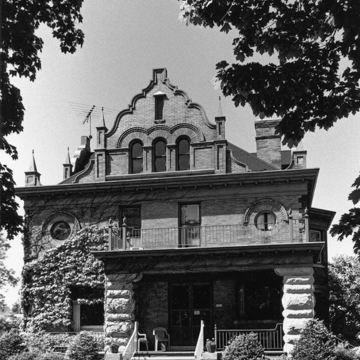This house is a notable example of German Renaissance Revival, a lavish style made fashionable in the late nineteenth century by wealthy Germans in cities like Dresden and Berlin. Well-to-do German immigrants in Milwaukee built houses in this style, but examples outside Milwaukee are rare. Strangely enough, the Nash House, although decidedly Germanic, was built for a lawyer and civic leader of Yankee stock. The house bears two features characteristic of the style: curvilinear gables on all four sides and pyramidal finials on the gables and the corners of the hipped roof. The two-and-a-half-story, cream brick house has a distinctively German squatness, thanks to its wide, bracketed eaves, massive quarry-faced limestone piers supporting the one-story porch, and round arches in the gables.
You are here
Lyman and Emma Nash House
If SAH Archipedia has been useful to you, please consider supporting it.
SAH Archipedia tells the story of the United States through its buildings, landscapes, and cities. This freely available resource empowers the public with authoritative knowledge that deepens their understanding and appreciation of the built environment. But the Society of Architectural Historians, which created SAH Archipedia with University of Virginia Press, needs your support to maintain the high-caliber research, writing, photography, cartography, editing, design, and programming that make SAH Archipedia a trusted online resource available to all who value the history of place, heritage tourism, and learning.







